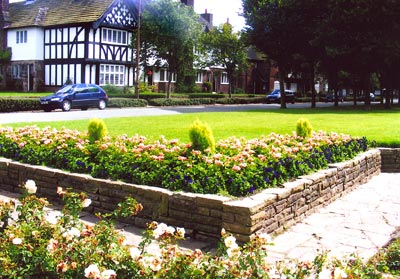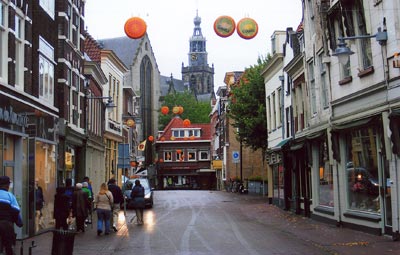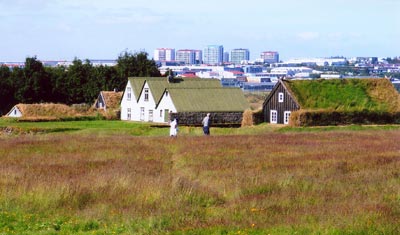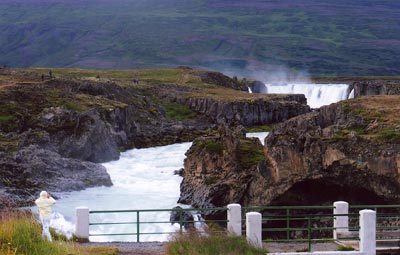Reflecting on the merits and disadvantages of cruising
by Larry Hughes, Houston, TX
Historians will often point out that the reason we remember Columbus is that he was the last to discover the Americas. From A.D. 900 or so on, continental America was well known to the seafaring Vikings. There were settlements in Newfoundland and evidence of Viking life in Iceland and the Faroe Islands.
We followed the trail of the Vikings on a summer 2007 trip aboard Holland America Line’s Maasdam.
The voyage
Travelers on HAL’s “Voyage of the Vikings” get full exposure to the early history of the Viking’s New World travels. The voyage is much more than Newfoundland, Greenland, Iceland and the Faroe Islands. One travels as well to Norway, the Netherlands, France and the British Isles. The highlights of our trip were the four stops in Iceland — a land of great beauty and, surprising to us, much greenery.
Choosing to cruise
Cruising is an easy way to go. One’s needs are taken care of and, with the right voyage, there can be much excitement. We don’t cruise that much; cruising, in many ways, is limited to port cities and their environs, so if one wants to see much of a country, cruising might not be the way to go.
Even with four stops in Iceland, we had a feeling of great limitation. Nevertheless, for sheer exposure to a lot of the world in a relatively brief span of time, cruising does have much to recommend it. Just be aware of what you are missing.
For example, we stopped in Le Havre and two of the offered tours involved a trip to Paris or the Normandy beaches. Looking at the timetable, I could see that on each of these 10-hour trips, seven hours was spent busing to and from the sites. That left about three hours for sightseeing — not much time in Paris or at the historic beaches.
Considering the costs
Moreover, shore excursions are not cheap. Even the 3-hour ventures started at $60 or so, and longer ones cost a couple hundred or more. The least expensive one we saw (and paid for) was a 45-dollar, 3-hour bus tour of the Faroe Islands. The most that we were charged was $200 for a 4-hour tour of Akureyri in Iceland. Those trips that involved air travel were even higher priced, of course.
We usually do not take a lot of the optional excursions, preferring to either hire a cab, take a local bus or, better, walk around the villages and towns and have lunch at a plaza café. Sometimes this is not cheap, but it is more focused — and easy to do if one has read a bit about a place.
Our excursion costs for this trip totaled over $600. We took excursions in Reykjavík; Akureyri; the Faroes; Gouda, Holland; Dublin, and Port Sunlight Village, England. We also took two excursions in Newfoundland. There was a good tour offered in Oslo for $160, but we had been to Oslo and all of the stops on the tour so did not opt for it.
That brings me to another aspect of this critique. Nothing about cruising is cheap. (Holland America even charges $2 for a soft drink.) Wine costs for modest vintages are high, and if you bring your own wine there are corkage charges, which on some ships can be as high as $20 a bottle. Using the ship’s Internet comes at a high price, as well.
Some events on the ship are free, while others include a charge. We paid nearly $20 for a wine tasting for the two of us.
Dining, of course, is included — unless you choose to go to the special restaurants. On the Maasdam, reservations got us into the Pinnacle Grill, a small elite restaurant. It’s a nice place and the service was excellent. The fee for this adventure was listed as “nominal.” “Nominal,” in the parlance of Holland America, meant $30 per person.
Tipping policies vary by cruise line. With Holland America, tipping of all but bar personnel and wine stewards is preimposed. There was a 15% pay-as-you-go tip charge for drinks. While we didn’t find the amounts out of line, we prefer to do our own tipping, not because it is cheaper for us — we usually pay more — but because we prefer to differentiate depending on the service we have received.
Our advice to the cruise lines is to pay your out-of-sight service personnel adequately and let the passenger do the tipping otherwise. (Our conversations with stateroom stewards and dining room servers indicated that they had been “doing better” when tipping was left up to the individual.)
Entertainment
Onboard entertainment varies widely on cruise ships, both in kind and quality. All ships have an evening show, varying from stand-up comedians to jugglers, magicians, instrumentalists and vocalists. There also is usually an on-board cast of dancers and singers doing variety shows.
Lecturers are scheduled and these folks are always pretty good. On this trip, we had Professor Mendelsohn for a series of lectures about literature and he was excellent, as was Joe L’Episcopo, who briefed us each time on the cities we were going to visit. (“Brief” is probably not the right word. His lectures were nearly an hour long and frequently included slides and videos.)
There were other lecturers as well, including chefs. Some were better than others, but all worked hard. And that would characterize all of the staff we met on the Maasdam: hard workers.
For those interested, there were trivia contests and athletic “events” plus daily concerts ranging from jazz to classical music in the various lounges. First-rate movies also were offered.
Wagerers could find much to do in the casino, which was open daily except when the ship was in port. And those who didn’t want to be caught up in a bunch of activities could retire to the library, a large place with ample books for lending.
Memorable moments
The trip itself was magical at times — icebergs and ice fields shining brightly on a blue ocean; seals and whales on display; puffins strolling through parts of Iceland, and street scenes in the marketplace of Stavanger, Norway. We also enjoyed sampling cheeses in Gouda; strolling the paths of St. Stephens Green in Dublin; quaffing some Guinness at an outside café in Cobh; walking with the “Vikings” at L’Anse aux Meadows in Newfoundland, and sailing through Greenland’s Prince Christian Sound.
An especially interesting and beautiful spot was the large botanical garden in Akureyri, Iceland, inside the Arctic Circle.
Cruising may not be for everyone, but it can be, as it is for us, a nice diversion once in a while or, perhaps for some, a once-in-a-lifetime trip. Just be aware that the sights are sometimes limited and the costs far exceed what is stated in the brochures that persuade you to come. Our total costs, including $1,530 for insurance, were nearly $23,000 on this 35-day cruise, which began and ended in Boston.
Is it worth it? Sure! As long as you know what you are getting into.





